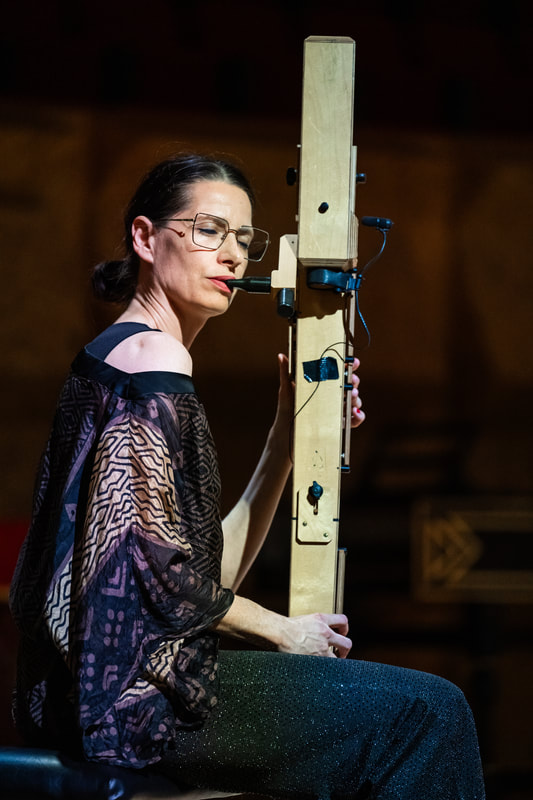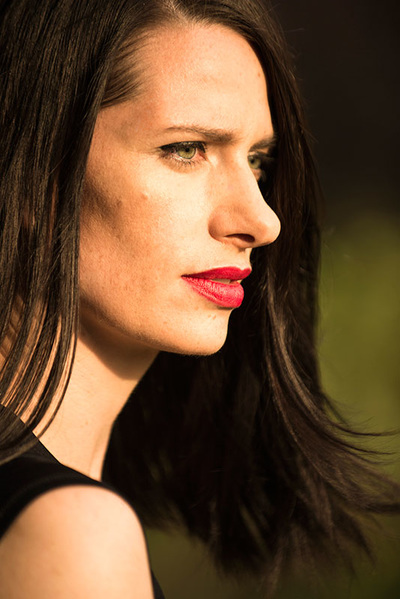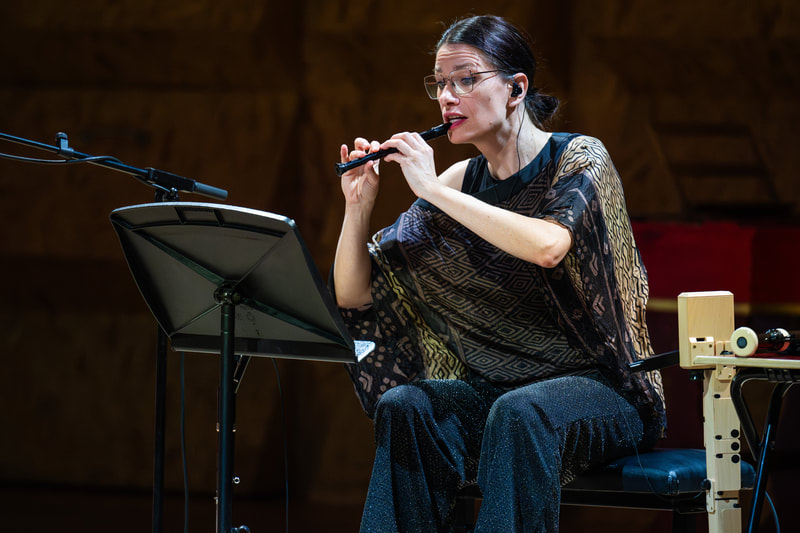Insights into current projects - Einblicke in aktuelle Programme
- The new potential of a 21st century recorder -
Since its beginnings in the 14th century, the recorder has been undergoing a constant process of transformation as it continually weaves itself into the musical tapestry of the changing times. The variety of designs it has taken throughout history has given us the possibility of working not only with historical instruments, but also with contemporary recorder models. However, the picture is not what one would expect. Copies of historical instruments are still predominantly used for all musical forms and styles, and I work to answer the questions: to which degree can contemporary recorder models enrich the contemporary repertoire, add to the catalogue of available playing techniques, and expand recorder performance practice to fulfil the new challenges and demands of contemporary music.
In my research, I mainly focus on a specific model, the Helder Tenor, which was developed in the 1990s by Maarten Helder and fulfils many of the requirements expected from a recorder in the 21st century: balanced volume, dynamic possibilities, extended pitch range, and an increased variety of tone colours. With regards to method, extended instrumental techniques, and performance practice of this and many more contemporary recorder models, we find ourselves at a beginning point with a world of information yet to research, gauge, and document.
> Dissertation
> Appendix
- Recorder Now
Since the academic year 2023, recorder player Susanne Fröhlich and recorder player Carsten Eckert have been leading the recorder class at the UdK Berlin. Both are interpreters and researchers, respectively, who enjoy an international reputation as specialists in the historical and contemporary recorder repertoire. The special feature of their program is that both early and contemporary music are treated with equal weight and thoroughness, depending on the individual orientation, so that the rich spectrum of the recorder is already focused on equally in the training.
- New Favorites -
For me as an artist it is important to keep an open mind, to stay inspired and to look for new paths of exploration. Therefore I will present a few of my new favorite composers, such as Chaya Czernowin and Hollis Taylor as well as movements from a cycle called "Jahreszeichen" composed by Markus Zahnhausen. Their music speaks very deeply to me and has influenced my work as a musician a lot, especially when it comes to the recorder models I am performing on. In this concert you will experience the immense diversity of the recorder family, including a few new recorder models.
- SPAT Kollektiv -
Susanne Fröhlich und Gerriet K. Sharma lernten sich 2016 im Rahmen ihres künstlerisch wissenschaftlichen Doktoratsstudiums an der Kunstuniversität in Graz kennen. Beide erforschten hier sowohl praktisch als auch theoretisch zwei außergewöhnliche und zugleich irritierende Pionierinstrumente: Helder Tenorblockflöte und Ikosaeder Lautsprecher. In ihrem ersten gemeinsamen Projekt Semaphor haben sie dialogisch das erzeugbare Wahrnehmungsspektrum beider Instrumente aufgedeckt und damit die ästhetischen Möglichkeiten der Raum-Klangkomposition im Jetzt erweitert.
Als Duo arbeiten sie aktuell an dem Projekt Interspecies - Präsenzen unwahrscheinlicher Raum-Zeit-Funktionen mit performativen Installationsaufbauten, in denen der Versuch einer Deklination von intermedialen Körper-Raumbeziehungen unternommen wird. Dabei kollidieren akustische Medien als Raum-Klang Projektionsverfahren nicht-kartesicher Raumvorstellungen mit gebauter Architektur und Körpern als Vermittler zwischen gelebtem und gedachtem Raum.
- recorder evolution -
Ein spannungsgeladenes Programm, das dem facettenreichen und virtuosen Spiel moderner Blockflöten gewidmet ist. Im Fokus stehen etwa 50 Jahre Evolution im musikgeschichtlichen und flötenbautechnischen Kontext. Angefangen bei sphärischer Spektralmusik, über traditionelle Avantgarde, hin zur smarten Rockhommage, wird das Konzert zu einem Parcours unterschiedlicher Genres und somit zu einem abwechslungsreichen Hörerlebnis.
- bon voyage -
mit Katharina Landl (Klavier)
Das außergewöhnliche Duo steht für klangästhetische, leidenschaftliche Interpretation zeitgenössischer Musik, das seine Hörer immer wieder aufs Neue in den Bann zieht. In "bon voyage" tauchen die beiden preisgekrönten Musikerinnen in faszinierend neue Klangwelten und begeben sich auf eine spannende Entdeckungsreise durch die unterschiedlichsten Genres aktueller Musik. Ein kurzweiliger Ohrenschmaus.
- The new potential of a 21st century recorder -
Since its beginnings in the 14th century, the recorder has been undergoing a constant process of transformation as it continually weaves itself into the musical tapestry of the changing times. The variety of designs it has taken throughout history has given us the possibility of working not only with historical instruments, but also with contemporary recorder models. However, the picture is not what one would expect. Copies of historical instruments are still predominantly used for all musical forms and styles, and I work to answer the questions: to which degree can contemporary recorder models enrich the contemporary repertoire, add to the catalogue of available playing techniques, and expand recorder performance practice to fulfil the new challenges and demands of contemporary music.
In my research, I mainly focus on a specific model, the Helder Tenor, which was developed in the 1990s by Maarten Helder and fulfils many of the requirements expected from a recorder in the 21st century: balanced volume, dynamic possibilities, extended pitch range, and an increased variety of tone colours. With regards to method, extended instrumental techniques, and performance practice of this and many more contemporary recorder models, we find ourselves at a beginning point with a world of information yet to research, gauge, and document.
> Dissertation
> Appendix
- Recorder Now
Since the academic year 2023, recorder player Susanne Fröhlich and recorder player Carsten Eckert have been leading the recorder class at the UdK Berlin. Both are interpreters and researchers, respectively, who enjoy an international reputation as specialists in the historical and contemporary recorder repertoire. The special feature of their program is that both early and contemporary music are treated with equal weight and thoroughness, depending on the individual orientation, so that the rich spectrum of the recorder is already focused on equally in the training.
- New Favorites -
For me as an artist it is important to keep an open mind, to stay inspired and to look for new paths of exploration. Therefore I will present a few of my new favorite composers, such as Chaya Czernowin and Hollis Taylor as well as movements from a cycle called "Jahreszeichen" composed by Markus Zahnhausen. Their music speaks very deeply to me and has influenced my work as a musician a lot, especially when it comes to the recorder models I am performing on. In this concert you will experience the immense diversity of the recorder family, including a few new recorder models.
- SPAT Kollektiv -
Susanne Fröhlich und Gerriet K. Sharma lernten sich 2016 im Rahmen ihres künstlerisch wissenschaftlichen Doktoratsstudiums an der Kunstuniversität in Graz kennen. Beide erforschten hier sowohl praktisch als auch theoretisch zwei außergewöhnliche und zugleich irritierende Pionierinstrumente: Helder Tenorblockflöte und Ikosaeder Lautsprecher. In ihrem ersten gemeinsamen Projekt Semaphor haben sie dialogisch das erzeugbare Wahrnehmungsspektrum beider Instrumente aufgedeckt und damit die ästhetischen Möglichkeiten der Raum-Klangkomposition im Jetzt erweitert.
Als Duo arbeiten sie aktuell an dem Projekt Interspecies - Präsenzen unwahrscheinlicher Raum-Zeit-Funktionen mit performativen Installationsaufbauten, in denen der Versuch einer Deklination von intermedialen Körper-Raumbeziehungen unternommen wird. Dabei kollidieren akustische Medien als Raum-Klang Projektionsverfahren nicht-kartesicher Raumvorstellungen mit gebauter Architektur und Körpern als Vermittler zwischen gelebtem und gedachtem Raum.
- recorder evolution -
Ein spannungsgeladenes Programm, das dem facettenreichen und virtuosen Spiel moderner Blockflöten gewidmet ist. Im Fokus stehen etwa 50 Jahre Evolution im musikgeschichtlichen und flötenbautechnischen Kontext. Angefangen bei sphärischer Spektralmusik, über traditionelle Avantgarde, hin zur smarten Rockhommage, wird das Konzert zu einem Parcours unterschiedlicher Genres und somit zu einem abwechslungsreichen Hörerlebnis.
- bon voyage -
mit Katharina Landl (Klavier)
Das außergewöhnliche Duo steht für klangästhetische, leidenschaftliche Interpretation zeitgenössischer Musik, das seine Hörer immer wieder aufs Neue in den Bann zieht. In "bon voyage" tauchen die beiden preisgekrönten Musikerinnen in faszinierend neue Klangwelten und begeben sich auf eine spannende Entdeckungsreise durch die unterschiedlichsten Genres aktueller Musik. Ein kurzweiliger Ohrenschmaus.


